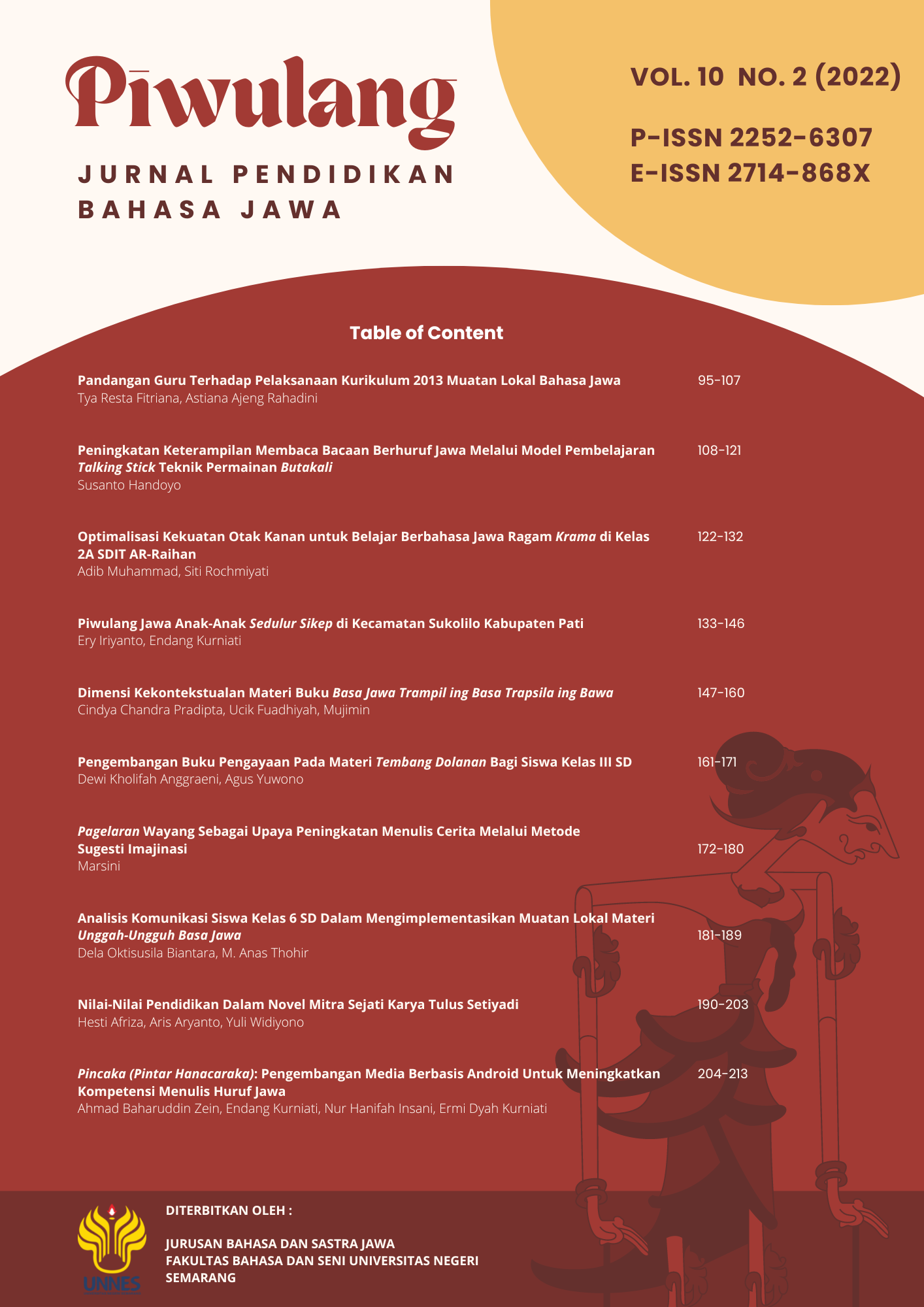Pengembangan Buku Pengayaan Pada Materi Tembang Dolanan Bagi Siswa Kelas III SD
##plugins.themes.academic_pro.article.main##
Abstract
In learning at school, sometimes teachers find it difficult to explain and teach the tembang dolanan due to the lack of teaching materials that explain details about it. The purpose of this study was to determine the teacher's needs for the development of enrichment books, compile a prototype for the development of enrichment books, and describe the results of the expert validation test on the development of enrichment books. This research was conducted using an R&D approach from Borg & Gall. The target sources data are students, teachers, media experts, and material experts. Data collection techniques are interview techniques and filling out questionnaires. The results of this study include (1) the analysis of teacher needs for the development of enrichment books on the material (tembang dolanan), that teachers want interesting complementary teaching materials for learning tembang dolanan for third-grade elementary school students. (2) the development of the prototype includes a book cover designed with children's pictures, while the contents of the book consist of ten lists of dolanan songs and their meanings. (3) The results of the expert validation test got several improvements from the validator, namely, adding page numbers, changing the title font of the dolanan song, correcting wrong diction, correcting wrong lyrics, and replacing some dolanan songs that are not in accordance with learning.
##plugins.themes.academic_pro.article.details##
References
Anugro, B. (2017). Pengembangan Buku Saku Tembang dolanan Sebagai Upaya Penguatan Pendidikan Karakter Untuk Kelas 4 SDN Girimoyo 02 Karangploso Malang. Skripsi Universitas Muhammadiyah Malang.
Cahyaningrum, N., & Kusumastuti, E. (2014). Dolanan Dance Learning on Supervising Pre-Service Teachers during Teaching Practicum Program. Harmonia: Journal of Arts Research and Education, 14(2), 78-87. https://doi.org/10.15294/harmonia.v14i2.3289
Hadi, P. K., Maruti, E. S., & Hartini. (2017). The Development of Teaching Material Based on Savi Approach on Tembang dolanan Material for Elementary School Students. Proceedings of the 2nd International Conference on Educational Management and Administration (CoEMA 2017), 48–52. https://doi.org/10.2991/coema-17.2017.9
Hardiyan, R. C., Aesijah, S., & Suharto. (2019). Pembelajaran Lagu Dolanan untuk Menanamkan Nilai Karakter pada Siswa SD Negeri Sekaran 01. Jurnal Seni Musik, 8(2), 105–115. https://doi.org/10.15294/jsm.v8i2.35048
Hayati, M., Nugroho, Y., & Purnomo, S. (2020). Pengembangan Buku Pengayaan Teks Dialog Banyumasan Berbasis Pitutur Luhur Pupuh Gambuh untuk Siswa Kelas VIII SMP. Piwulang: Jurnal Pendidikan Bahasa Jawa, 8(1), 71-79. https://doi.org/10.15294/piwulang.v8i1.30199
Heldisari, H. P. (2020). Building Characters of Primary School Students Through Lagu Dolanan Anak (Kid’s Playing Songs) by Using The Role-Playing Method. Journal of Education Research and Evaluation, 4(1), 1-7. https://doi.org/10.23887/jere.v4i1.23324
Jarmani. (2017). Pelestarian Lagu-Lagu Dolanan Melalui Pengembangan Materi Ajar Ekstrakurikuler Musik Patrol Berbasis Garap Musik Kreatif di SDN Babatan IV Surabaya. Seminar Nasional PGSD UNIKAMA, Vol. 1, Desember, 234-243. https://semnas.unikama.ac.id/pgsd/unduhan/2017/3882542594.pdf
Kamalia, I. (2020). Pengembangan Buku Pengayaan Bergambar Keterampilan Menulis (Meringkas) Untuk Siswa Kelas Vii Se-Kecamatan Pemalang. Piwulang: Jurnal Pendidikan Bahasa Jawa, 7(2), 34-43. https://doi.org/10.15294/piwulang.v7i2.29681
Kumyati. (2018). Peningkatan Minat Dan Keterampilan Bercerita Pada Pembelajaran Bahasa Jawa Dengan Penggunaan Alat Peraga Wayang Kulit Pada Siswa Kelas VI. Jurnal Elementary School: Jurnal Pendidikan dan Pembelajaran Ke-SD-an, 5(2), 253-260. https://doi.org/10.31316/esjurnal.v5i2.303
Kurniasari, D. A. D., Rusilowati, A., & Subekti, N. (2014). Pengembangan Buku Suplemen IPA Terpadu dengan Tema Pendengaran Kelas VIII. Unnes Science Education Journal, 3 (2), 462-467. https://journal.unnes.ac.id/sju/index.php/usej/article/view/3329
Malikhah, S. (2020). Pengambangan Buku Cerita Rakyat di Jepara sebagai Pengayaan Materi Ajar Legenda Kelas VIII SMP. Piwulang: Jurnal Pendidikan Bahasa Jawa, 7(2), 1-9. https://doi.org/10.15294/piwulang.v7i2.29500
Maryam, S. (2012). Strengthening the Character: Uphold Ethics in Indonesian Language Study Pass by Supplementary Books. EDUCARE: International Journal for Educational Studies, 5(1), 39–50. https://journals.mindamas.com/index.php/educare/article/view/264
Murdiyastomo, H. A. (2017). Serat Wedatama and Character Education. Journal of Social Studies, Vol. 13(1), 63 – 69. https://journal.uny.ac.id/index.php/jss/article/view/16974/9979
Nurhidayati. (2016). Pelestarian Budaya Jawa Melalui Lagu Dolanan. FBS UNY.
Prancisca, S., & Fergina, A. (2020). Evaluating “West Kalimantan Culinary Book” as A Supplementary Book for Undergraduate Students. JETL (Journal of Education, Teaching and Learning), 5(1), 81-87. https://doi.org/10.26737/jetl.v5i1.1437
Prastya, D. (2020). Pengembangan Instrumen Penilaian Mendengarkan Sandiwara Bahasa Jawa Smp Kelas IX Berbasis Kultural di Kota Semarang. Piwulang: Jurnal Pendidikan Bahasa Jawa, 7(2), 21-27. https://doi.org/10.15294/piwulang.v7i2.19737
Pratiwi, U. R. & Widyaningrum, T. (2021). Analisis Kualitas dan Efektivitas Pemanfaatan Buku Ajar. Edu Sains 9(2), 164-177. https://doi.org/10.23971/eds.v9i2.2271
Prilosadoso, B. H., Atmaja, N. R. A. C. D., & Murwanti, S. (2021). Revitalization of Folklore and Actualization Efforts Through Visualization Animation Media in Early Childhood Character Building. International Journal of Social Sciences and Humanities, 5(1), 1–8. https://doi.org/10.29332/ijssh.v5n1.590
Siregar, D. Y. (2017). Methaphorical Meaning Inside Tembang Dolanan. Jurnal VISION, 11 (11), 1–16. http://dx.doi.org/10.30829/vis.v11i11.164
Susanti, U. (2020). Pengembangan Media Pembelajaran Menggunakan Rekaman Siaran Radio Berbasis Kontekstual Sebagai Materi Dialog Berbahasa Jawa. Piwulang: Jurnal Pendidikan Bahasa Jawa, 7(2), 53-61. https://doi.org/10.15294/piwulang.v7i2.3003
